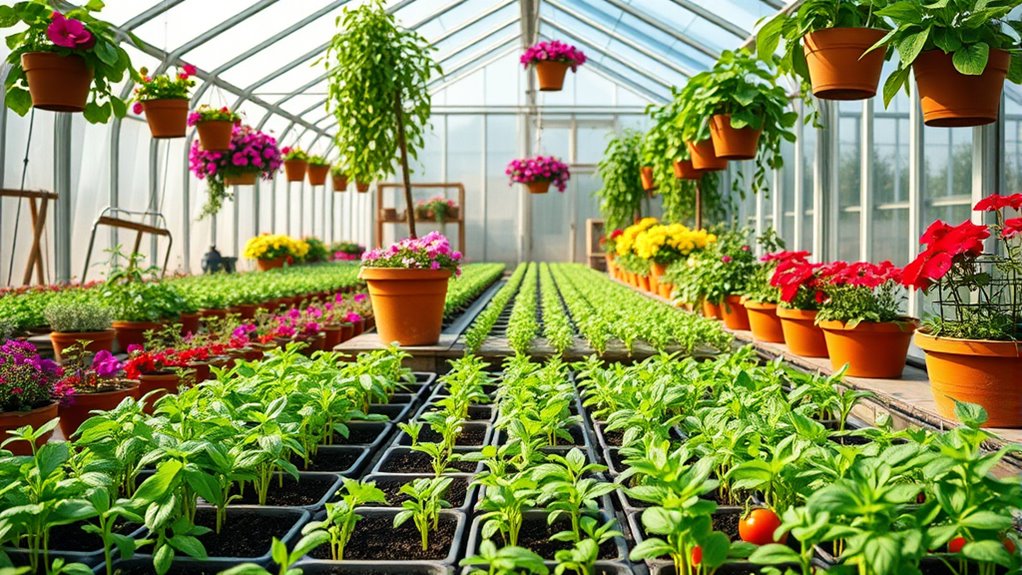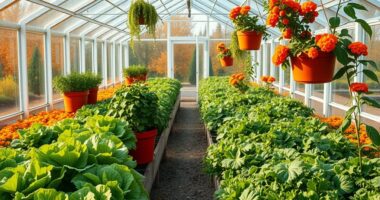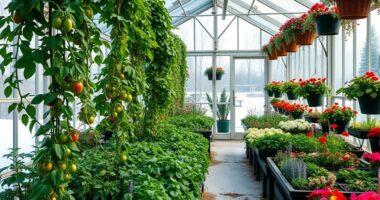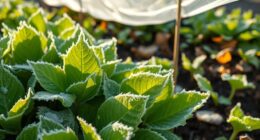In your spring greenhouse, start with quick-growing vegetables like lettuce, spinach, radishes, and tomatoes, focusing on early season success. Add herbs such as parsley, chives, and cilantro for natural pest control, and brighten the space with flowering plants like petunias and marigolds. Prepare your greenhouse by cleaning, sterilizing soil, and maintaining proper airflow and humidity. Keep consistent watering and monitor conditions closely—exploring these tips can help you create a thriving, vibrant garden all season long.
Key Takeaways
- Select cool-season crops like lettuce, spinach, radishes, and early tomatoes for spring greenhouse planting.
- Prepare the greenhouse by cleaning, sanitizing, and adjusting environmental controls for optimal conditions.
- Use companion planting with herbs and flowers to enhance pest control and soil health.
- Maintain consistent watering, ventilation, and humidity levels to prevent diseases and promote healthy growth.
- Incorporate fragrant and easy-care plants like petunias and marigolds for vibrant, inviting greenhouse aesthetics.
Selecting the Right Crops for Spring in the Greenhouse
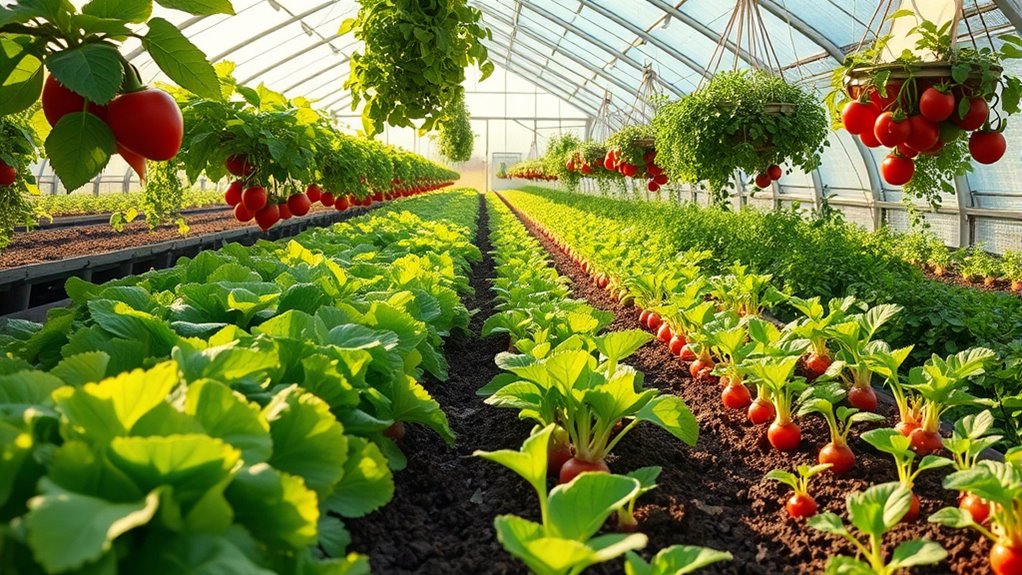
Choosing the right crops for spring in your greenhouse sets the foundation for a successful growing season. Start by selecting plants that thrive in early spring conditions, such as lettuce, spinach, and radishes. Incorporate companion planting to boost plant health and deter pests—pair basil with tomatoes or marigolds with peppers for natural protection. Utilizing seasonal crop planning can help you optimize your planting schedule and yields. Implementing soil testing allows you to better understand your soil’s nutrient levels and adjust fertilization accordingly, promoting healthier plant growth. Practice crop rotation to prevent soil depletion and reduce disease risks; avoid planting the same family of vegetables in the same spot each year. This helps maintain soil fertility and keeps pests at bay. Additionally, understanding optimal soil conditions can improve plant growth and yield in your greenhouse. Being aware of state tax laws can influence your planning for crop sales or farm income, ensuring you maximize profits and minimize tax liabilities. Implementing integrated pest management strategies can further safeguard your crops from common pests and diseases, promoting healthier plants.
Preparing Your Greenhouse for Spring Planting
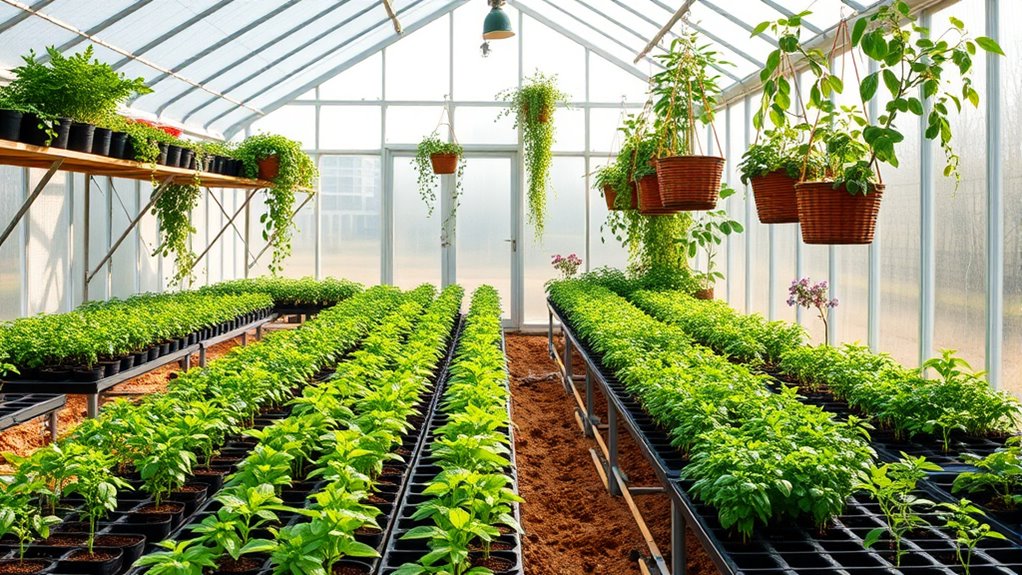
Before planting, you need to thoroughly clean and sanitize your greenhouse to prevent pests and diseases.
Make sure your ventilation system is working properly to control humidity and keep the air fresh.
Adjusting these elements now helps create an excellent environment for your spring crops to thrive.
Cleaning and Sanitizing
Have you thoroughly cleaned and sanitized your greenhouse to guarantee a healthy start for your spring plants? Begin by removing all debris, dead plant material, and any clutter.
Next, focus on soil sterilization; this helps eliminate pests, fungi, and diseases that could harm your new crops. You can achieve this by heating the soil or using a steam sterilizer. Using tools such as electric dirt bikes as an analogy, proper sterilization ensures your environment is free of harmful contaminants, much like how electric dirt bikes produce clean energy without emissions. Incorporating proper sterilization techniques further enhances the effectiveness of your efforts.
Equally important is equipment sanitation—clean and disinfect tools, trays, and pots with a bleach solution or commercial disinfectant. This step prevents the spread of pathogens. Regular maintenance of your tools also helps preserve their longevity and functionality. Additionally, maintaining a clean workspace reduces the risk of cross-contamination and promotes healthier plant growth.
Don’t forget to wipe down benches, shelves, and any surfaces that come into contact with plants. Maintaining a clean workspace minimizes the risk of cross-contamination.
Proper cleaning and sanitizing create a fresh environment, reducing disease risks and setting the stage for healthy, vigorous growth this spring. Soil sterilization is a crucial step to ensure your plants thrive and remain healthy throughout the season.
Ventilation and Humidity
After thoroughly cleaning and sanitizing your greenhouse, focusing on proper ventilation and humidity control will guarantee ideal conditions for your spring plants. Good air circulation prevents stagnant air and reduces the risk of mold and pests. You can improve airflow by opening vents, using exhaust fans, or installing oscillating fans. Moisture control is equally essential; maintaining appropriate humidity levels prevents diseases like damping-off or powdery mildew. Use a hygrometer to monitor humidity and adjust ventilation accordingly. If the air is too humid, increase airflow; if it’s too dry, add a humidifier or mist plants lightly. Consistent ventilation and moisture management create a healthy environment, promoting strong growth and ensuring your spring plants thrive in suitable conditions. Additionally, understanding seasonal variations can help you adapt your greenhouse environment throughout spring for optimal plant health.
Best Vegetables to Grow in Your Spring Greenhouse
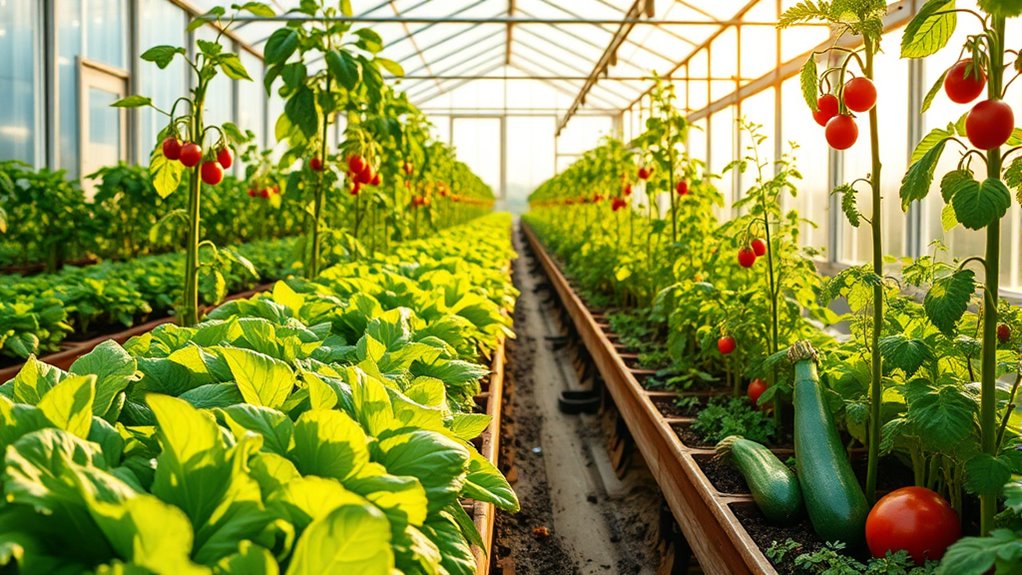
Spring is the perfect time to start growing vegetables in your greenhouse, giving them a head start before outdoor planting. Some of the best vegetables to grow include:
- Lettuce – quick to mature and ideal for companion planting to deter pests.
- Spinach – thrives in cooler temperatures and benefits from pest management strategies.
- Radishes – grow rapidly and can be interplanted with carrots or cucumbers.
- Tomatoes – flourish indoors early and respond well to companion planting with basil and marigolds for pest control.
These vegetables are easy to manage and benefit from thoughtful companion planting, which helps naturally reduce pests. Additionally, using proper soil conditions can significantly improve growth and yield. Starting them now guarantees healthy growth and a productive harvest when outdoor conditions are ready.
Herbs That Thrive During Early Spring
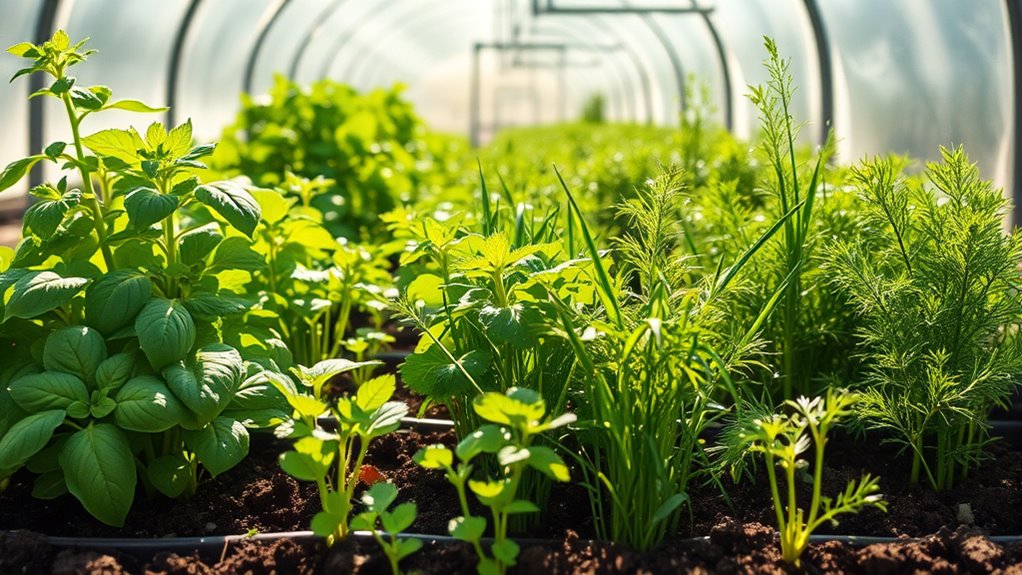
As the weather begins to warm, early spring is the ideal time to start growing herbs that thrive in cooler conditions. Herbs like chives, parsley, and cilantro flourish now and can be used for quick harvests. These herbs also make excellent companions for other plants, helping with pest management by attracting beneficial insects. Plant them near vegetables to deter pests naturally, reducing the need for chemical controls. Keep in mind that some herbs, like mint, spread quickly, so container gardening is best to keep them contained. Starting these hardy herbs early allows you to build a fresh supply for cooking and herbal remedies. Their resilience in early spring makes them essential additions to your greenhouse garden for a thriving, pest-managed herb patch. Using herbs as natural pest repellents can further enhance your garden’s health and productivity. Additionally, selecting appropriate growing conditions ensures these herbs develop strong roots and vibrant foliage, maximizing their benefits. Proper soil preparation and consistent watering will further support healthy growth during these early months, especially when considering climate considerations for optimal growth.
Flowering Plants to Brighten Your Greenhouse
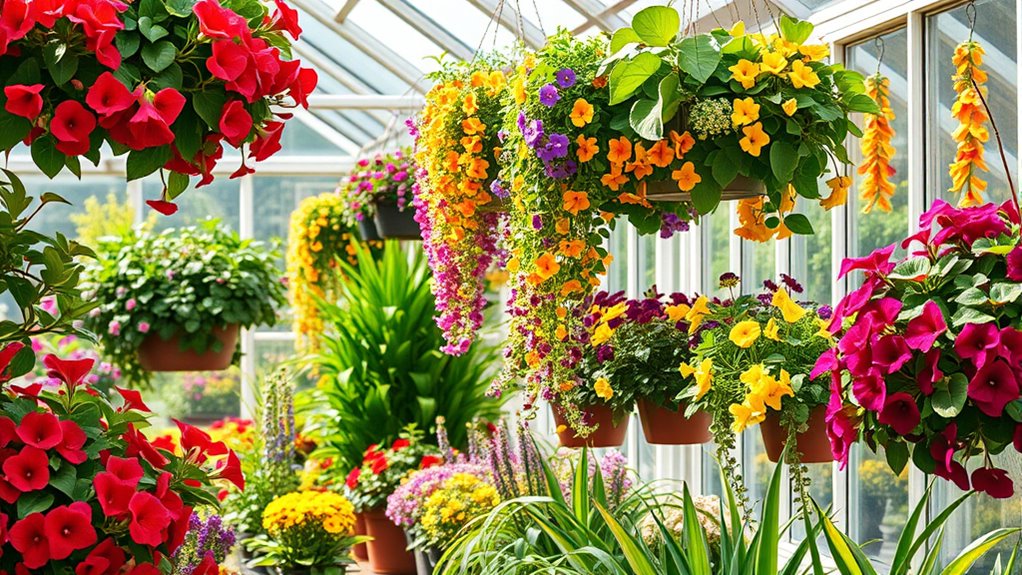
Adding flowering plants can instantly brighten your greenhouse and lift your spirits. You’ll find vibrant annuals, fragrant varieties, and easy-care options that suit your space. Including season-extending techniques can help keep your blooms thriving throughout the spring season. Being mindful of local regulations ensures that your planting choices support sustainable practices. Additionally, choosing plants with adaptability to automation can help streamline your maintenance routines and optimize growth conditions. Incorporating self watering plant pots can further simplify watering and promote healthy root development for your flowering plants.
Subheading 1: Vibrant Annual Blooms
Looking to instantly brighten your greenhouse? Vibrant annual blooms are perfect for adding color and energy to your space. These lively plants grow quickly and provide continuous blossoms.
To maximize their impact, consider companion planting to enhance soil health and attract beneficial insects. Here are four top choices:
- Petunias — Their bold colors fill gaps and attract pollinators.
- Marigolds — Bright and cheerful, they also deter pests naturally.
- Zinnias — Easy to grow, providing long-lasting, vivid blooms.
- Impatiens — Ideal for shaded areas, adding a splash of color.
Plant these annuals in well-draining soil enriched with organic matter. Regularly watering and rotating crops will keep soil healthy and blooms vibrant all season long. Understanding plant relationships can help you create a more resilient and thriving greenhouse environment.
Subheading 2: Fragrant Flower Varieties
Fragrant flower varieties can dramatically enhance the atmosphere of your greenhouse by filling it with delightful scents. Scented roses are a perfect choice, offering a range of fragrances from sweet to spicy that can fill your space with aroma. Fragrant lilies also add a lovely, strong scent, especially when in full bloom.
Position these plants near seating areas or vents to maximize their impact. Regular watering and proper airflow will keep their fragrances strong without causing mold or dampness. You might also consider adding other fragrant varieties like gardenias or jasmine for additional scent layers.
These plants not only brighten your greenhouse visually but turn it into a fragrant retreat that lifts your spirits every time you enter.
Subheading 3: Easy-Care Flowering Plants
If you want to brighten your greenhouse without the hassle of high-maintenance plants, easy-care flowering varieties are your ideal choice. These plants require minimal attention and thrive with simple succulent care routines. They also include shade-loving plants, perfect for spots with less direct sunlight.
Imagine vibrant blooms that need little watering or pruning, saving you time and effort. Consider these options:
- Geraniums – Bright, cheerful flowers that flourish in containers and tolerate shade.
- Impatiens – Shade-loving plants with colorful blossoms, perfect for low-light corners.
- Kalanchoe – Succulent with showy flowers, requiring infrequent watering and minimal care.
- Begonias – Easy to grow, with striking flowers that thrive in partial shade.
These plants will brighten your greenhouse effortlessly.
Care and Maintenance Tips for Spring Greenhouse Gardening
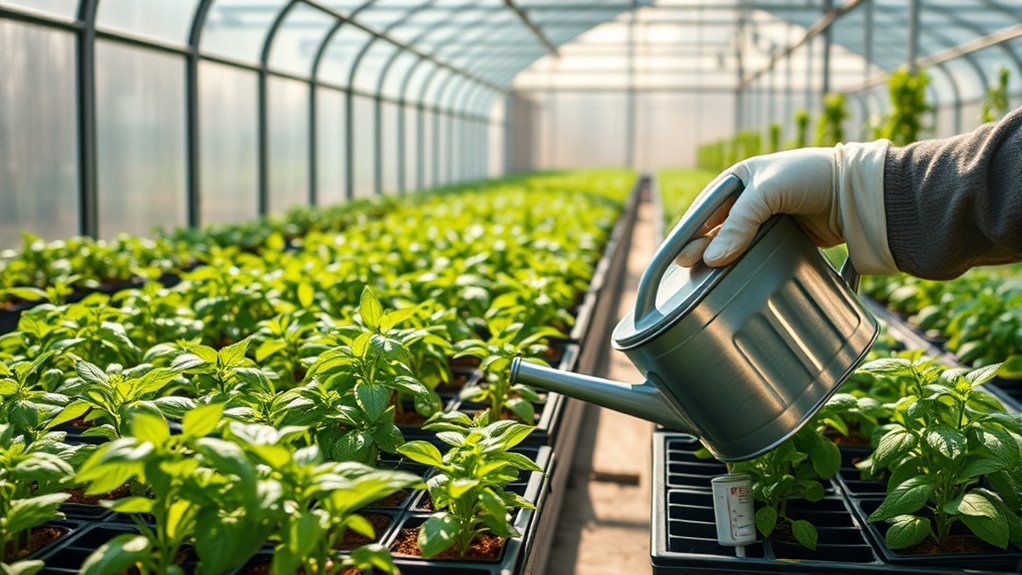
As spring arrives, maintaining your greenhouse becomes essential to guarantee healthy plant growth and a productive season. Regular pest control is crucial; inspect plants frequently for signs of pests and take prompt action with organic or chemical solutions.
Springtime greenhouse care ensures healthy growth through regular pest inspections and prompt treatment.
Keep a consistent watering schedule, ensuring your plants stay evenly moist without overwatering, which can cause root rot. Use well-draining soil and monitor humidity levels to prevent mold and mildew.
Ventilate your greenhouse daily to promote fresh air circulation and reduce disease risks. Clean tools and surfaces regularly to avoid the spread of pests and fungi.
Prune dead or damaged foliage to encourage healthy growth. By staying diligent with pest control, watering schedules, and cleanliness, you’ll create an ideal environment for your spring gardening success.
Frequently Asked Questions
How Can I Control Pests Naturally in My Spring Greenhouse?
You can control pests naturally by using companion planting, which attracts beneficial insects that prey on pests. Incorporate natural repellents like neem oil or garlic spray to deter unwanted bugs.
Regularly inspect your plants and remove affected areas promptly. Creating a healthy environment with proper airflow and avoiding overwatering also helps prevent pest infestations.
These methods keep your greenhouse pest-free without harmful chemicals, promoting healthy, thriving plants.
What Are the Best Lighting Conditions for Spring Crops?
It might seem like a coincidence, but your spring crops thrive best when you meet their sunlight requirements.
For ideal growth, guarantee your greenhouse provides ample light intensity, especially during cloudy days. Position plants where they can receive direct sunlight or supplement with grow lights if needed.
Consistent, adequate lighting helps your crops grow strong and healthy, making your spring gardening efforts more successful.
How Do I Manage Humidity Levels During Spring?
Managing humidity levels during spring is essential for healthy greenhouse plants. You should focus on humidity control and moisture management by regularly monitoring the air moisture and using tools like humidifiers or dehumidifiers as needed.
Ventilate your greenhouse daily to prevent excess humidity and reduce the risk of mold. Proper airflow keeps humidity balanced, ensuring your plants stay healthy and thrive through the season.
When Should I Start Planting Seedlings Indoors?
Did you know that starting seedlings indoors can boost your garden’s success by 50%?
You should begin seedling timing about 6-8 weeks before your last frost date. Focus on indoor sowing schedules to give plants a strong start.
In general, start your seedlings indoors 6-8 weeks prior to transplanting outside, ensuring they’re healthy and robust when it’s time to move them outdoors.
What Organic Fertilizers Are Recommended for Spring Greenhouse Gardening?
For spring greenhouse gardening, you should select organic fertilizers like compost teas and homemade fertilizers to boost plant health.
Compost teas are easy to make and rich in nutrients, providing a natural boost.
Homemade fertilizers, such as fish emulsion or compost-based mixes, are affordable and effective.
Incorporate these into your routine to promote healthy growth, improve soil fertility, and guarantee a thriving greenhouse environment.
Conclusion
By choosing the right crops and preparing your greenhouse properly, you set the stage for a thriving spring garden. Regular care and maintenance keep plants healthy, ensuring you enjoy a vibrant display of vegetables, herbs, and flowers. Think of your greenhouse as a nurturing haven—when you invest time and effort, nature responds with beauty and bounty. With patience and consistency, you’ll find that spring gardening turns into a rewarding, lively experience.
